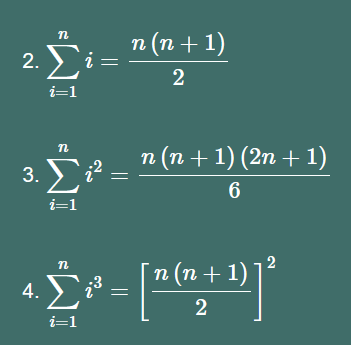I decide to learn Artificial Intelligence with C++. When i was reading some blog's about AI, i found out that i need to learn some mathematics. Then i started searching about what i need to learn.
I found a blog post about what math needed to learn. Here is the link.
All the Math You Need to Know in Artificial Intelligence
In summation subject i started watching a video which is
Video is good to see what is happening in summation notation but i need to find out the proof of these formulas.
Sum of the First n Positive Integers are well explained in here
We add all the number from (1 to n) [1 + 2 + 3 + ... + (n-2) + (n-1) + n] first. Then add all of them from (n to 1) [n + (n-1) + (n-2) + ... 3 + 2 + 1] second. If we add these two sums bottom to bottom we get values (n + 1) summed for n times (n + 1) * n. Because of we use sum of all the values for 2 times (first and second), we need to divide the whole sum by 2.[(n + 1)* n] / 2. That is okay and the image below explains it beautifully. Learning from the image is a better way i guess so i started searching for an image solution for i(square).
Gaussian proof for the sum of squares?
I found out an answer here
The image above, we are drawing 3 triangle starting from 1 to n. All triangles are starting from different corners.
(1^2) = 1 (Using 1 for one time in triangle)[1=1]
(2^2) = 4 (Using 2 for two times in triangle)[2+2=4]
(3^2) = 9 (Using 3 for three times in triangle)[3+3+3=9]
(n^2) -> (Using n for n times in square)[n+n+...+n ntimes=n^2]
So it is like adding whole sum for 3 times like the first example.
When we add all the values at the same place in all triangles, we get a (2n + 1) valued triangle.
First Row ->
(1 + n + n = 2n + 1)First Column Second Row ->
(2 + (n - 1) + n = 2n + 1)
Now we need to find out how many times we are using (2n+1) value in the last triangle. To understand it easily we can change all numbers to 1.
This is exactly what we do in first example. Sum of the values from 1 to n. The answer is [(n + 1)* n] / 2. We use (2n + 1) for [(n + 1)* n] / 2 times.
So now we have a triangle which have (2n + 1) value for [(n + 1)* n] / 2 times and this triangle created by 3 same triangle so the result of [(2n + 1) * ((n + 1)* n) / 2 ] needs to be divided by 3.
Final result is [((2n+1) * n * (n+1)) / (2 * 3)].
I could not found any answer like this for cube.
If you find out, let me know.
Here is a song for you
https://soundcloud.com/sturmtruppen1k17/subbbb-test-mastering-by-maukook
Have a good day!















Top comments (1)
Embarking on an exciting journey into Artificial Intelligence with C++ is a fantastic choice! It's not just about coding; understanding the foundations is key. Betbook 247 com login